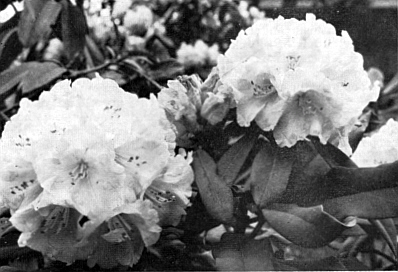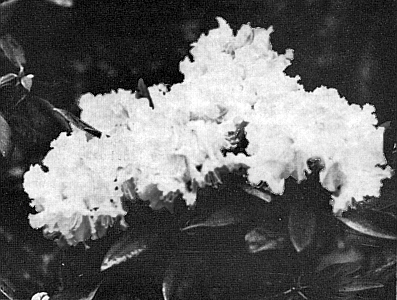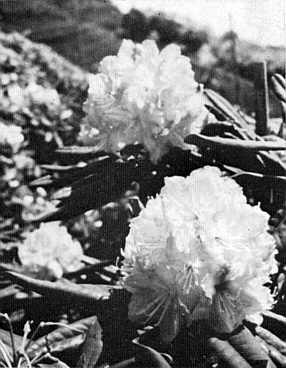Breeding Rhododendrons and Azaleas
K. Wada
A talk given on May 22, 1965 at the annual meeting of the ARS
at Oyster Bay, Long Island, N.Y.
Ladies and gentlemen,
First of all I must thank you for the wonderful kindness and help which your people have shown me during my short stay. I could see more than I had expected and could investigate quite enough. Japan has climates similar to the New York area and I considered I should learn more in your area than in England.
When I was young I was impressed with the beauty of Rhododendrons and tried to import all possible hybrids from England and Holland, and at the same time I gathered all different species from every corner of Japan. I was much discouraged afterwards to find almost all of them could not survive our hot summer, and only a few species could stand our sub-tropical heat. They were
R. fortunei
,
ponticum
,
arboreum
'Blood Red' and
metternianum
and some few others.
As I liked to try to turn anything "impossible" to "possible," I thought I could obtain beautiful hybrids by our own breeding from these tough species. Therefore, I made crosses in quite different ways from European people. Thus I could succeed in obtaining beautiful hybrids that can stand our sub-tropical summer. One of them was from the cross of
R. arboreum
'Blood Red' and
R. metternianum
. (Slide No. 1) From this tender species of
R. arboreum
'Blood Red' I would obtain quite hardy hybrids using the hardy
metternianum
.
R. arboreum
'Blood Red' is the king of the Rhododendron family.
R. metternianum
is most closely related to
R. yakushimanum
with larger individual flowers and better trusses. (Slide No. 2) All the seedlings of this cross have turned out to be first class. (Slide No. 3 close-up of a truss).

|
|
Fig. 49.
R. arboreum
'Blood Red' X
R. metternichii
Aff.
Photo by K. Wada |

|
|
Fig. 47.
R. metternianum
'Wada Rosea' x
R. metternichii
Aff., derived from the very beautiful native species, having hybrid vigor with waxy, jewel-like flowers in a large truss, warm rose pink with no bluish tinge. It opens very early in the spring, before 'Nobleanum' or 'Christmas Cheer'. The leaves are leathery dark green, green staying 4 years on the twigs. Photo by K. Wada |

|
|
Fig. 48. 'Elsa Crisp' x
R. metternianum
Photo from K. Wada |
Metternianum is the name tentatively given by me to a distinct species to separate it from the other Japanese species, but most closely related to
R. yakushimanum
, as I told you before. (Slide No. 4) From the second generation, I could obtain a
R. yakushimanum
like plant with large trusses of deepest blood red flowers as seen in 'Earl of Athlone'. As
R. metternianum
has large, substantial, waxy, jewel-like flowers of lasting quality, much ahead of the new shoots coming out, its hybrids all show the tendency of slowing down their sprouting. That is, they do not have the bad effect of new shoots coming out at the same time as the flowers and spoiling the beauty of the flowers. Next slides (Slides No. 5, 6, 7, 8, and 9) show some of my
metternianum
hybrids and you will observe they have no new leaves beside the flowers and that flowers can well stand the weather under full sun.
R. fortunei
has the characteristics of giving new growths at the same time as flowers and its flowers wither quickly under exposure and are easily stained by rain. These are undesirable characteristics, and to correct these defects millions of seedlings have been discarded by breeders all over the world.
In place of
R. fortunei
, I fortunately could find another tough species in Japan and this species was named by me as
R. metternichii
Aff., to separate from the
R. metternichii
forms.
Hondoense
and
tsukushianum
are forms of
R. metternichii
, probably differing from each other only in indumentum and have little, if any, difference in flower. They invariably have seven-lobed flowers. However, some forms are better than others. Horticulturally, "R.
metternichii
Aff." is quite distinct in having flowers 3 weeks ahead of the other
R. metternichii
and large, waxy, seven to ten lobed flowers, making a well-filled truss. When numbers of lobes are increased, the flowers get more widely open and give the appearance of a larger flower (Slides No. 10, 11 and 12). Its hybrids give in all cases seven-lobed flowers very early in the spring, before Azalea season, say, in Daffodil season, opening from dead dormancy. This early-blooming habit is very important to us in Japan and one of the important factors which attract the attention of the public. This discovery of mine of "R.
metternichii
Aff." has marked an epoch in my Rhododendron breeding project. Our hot summer starts from the beginning of May and everything is forced to bloom during May, started by evergreen Azaleas, and people get tired with flowers by the middle of May. Any plants blooming after that may fail to attract public attention (Slides No. 13, 14 and 15).
If you come to Japan you will be really surprised to find no Rhododendrons planted and growing in Japanese gardens. This indicates we could not grow Rhododendrons in our lowland countries. But I could change this 'could not' to 'can' and I expect you will some day see many Rhododendrons in Japanese gardens.
As I thought
R. chrysanthum
would be of considerable interest in your breeding projects I brought one color slide (Slide No. 16). This is an outstanding geographical form with very small leaves and more flowers to a truss. The flowers are yellow and large for the size of plant. I separated this form from other
R. chrysanthum
by giving a name of 'Wada's Form'. Probably this is the hardiest and slowest growing elepidote Rhododendron in the world. The plant shown is about 15 years old. It can be easily propagated by division or cuttings. I may some day produce many interesting dwarf hybrids for rock gardens.
Breeding of deciduous Azaleas that can stand our summer heat, drought and general garden conditions is a part of my breeding projects. I found
R. tashiroi
can stand these difficult environments better than Kurume Azaleas and any other deciduous Azaleas. It did not mind our drought and summer heat. I tried to cross it with
Rhododendron nudipes
,
reticulatum
and
shikokianum
.
R. nudipes
is itself a very beautiful species with rose colored flowers similar to
R. albrechtii
, with larger flowers and better constitution.
R. shikokianum
is similar to
R. weyrichii
, with brick red to orange red flowers, and
R. reticulatum
has purple flowers. The result was really outstanding and far from my initial expectation. The hybrids have quickly made a tall bush and have been covered with flowers. They are very twiggy and every branch has flowers, making the entire plant a mass of flowers. (Slides No. 17, 18 and 19)
R. tashiroi
is a little known species distributed in the southern part of Japan near the sea coast where in summer it is terribly hot and dry, but in Yakushima Island it climbs up to 4,000 to 5,000 feet high where
R. yakushimanum
is at home.
R. tashiroi
has dark green, leathery, evergreen leaves, similar to those of some lepidote species.
This picture (Slide No. 20) is of
R. reticulatum album
, little known to horticulture, but a most beautiful Azalea throughout the world, blooming before Azalea Kurume. I have also used this for breeding in the hope of increasing the color range of my
R. tashiroi
hybrids.
I brought a few pictures of my new red
Pieris
. The picture (Slide No. 21) does not show its true color but it is red rather than pink when opening. It is extremely floriferous, blooming profusely at a nursery stage. It flowers in Winter rather than in Spring. The picture (Slide No. 22) shows it is blooming at the same time as
Cyclamen
count. This picture (Slide No. 23) shows very long trusses and another one (Slide No. 24) tells it does not mind snow. It makes a very showy pot plant at Christmas time for florists and I named it
Pieris japonica rubra
'Christmas Cheer'.
In contrast to the above this (Slide No. 25) is a pure white Pieris with large flowers. It is outstanding in having a long truss having large pure white flowers, too heavy to stand upright. The flowers are pure white rather than milky white. It is named
Pieris japonica grandiflora
'Purity'. This
Pieris
is said to have come from Yakushima Island, the home of
R. yakushimanum
.
Thank you.